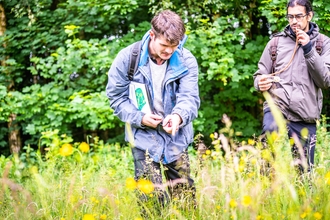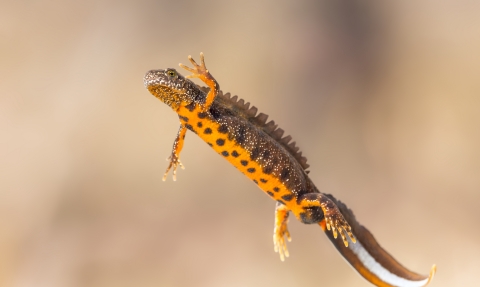
Newts
Amphibians such as newts, frogs, toads are animals which have lungs and live on land for part of their lives but return to water each year to lay their eggs. Amphibians have two distinct phases of growth. The juvenile or "tadpole" phase is dependent on water, whereas the adult is land-living. The transition from tadpole to adult involves a complete reorganisation or metamorphosis of the body form.
The newt tadpole looks more like the adult form, unlike frog or toad juveniles which do not. It has frilly gills which are kept throughout the tadpole stage but reabsorbed during metamorphosis. The fin on the tail is also reabsorbed and there are slight changes in the shape of the head and body. Adult newts have elongated bodies, well-developed tails and short slender legs for crawling. During the breeding season the males develop crests and flaps of skin on the hind toes, and brightly coloured skin on their underparts.
There are three species of newt native to the British Isles: the great crested newt, the smooth or common newt and the palmate newt. Britain has 3-4% of their global populations.
Identification
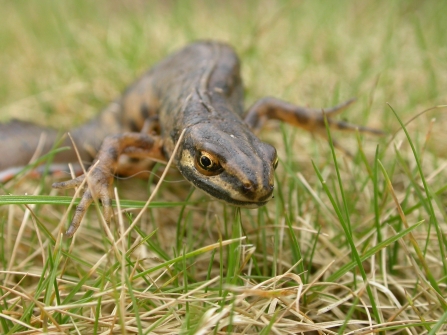
Credit: Philip Precey
Smooth or Common Newt Triturus vulgaris
Adults grow to 8-10 cm long. The skin is smooth and may look slightly velvety outside the breeding season. The male can be distinguished from the female by his larger throat spots and large swollen cloaca (reproductive opening). During the breeding season, the male acquires a high wavy crest along the back and tail, and is marked all over with black spots. In both sexes the belly ranges in colour from yellow orange, marked with dark blotches which are finer in the female. The female lacks a crest and is drab compared to the male.
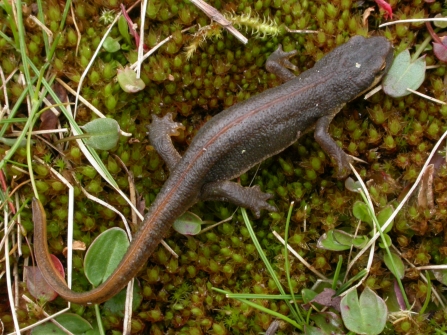
Credit: Philip Precey
Palmate Newt Triturus helveticus.
This is the smallest of the three species. The total length of a fully-grown adult male is about 8 cm, the female being slightly larger. Palmate and smooth newts look similar. However, they can be distinguished by inspection of the throats: the smooth newt has a white spotted throat whereas the palmate’s throat is pinkish and unspotted in both sexes. Like the male smooth newt, the male palmate newt has a crest during the breeding season but it is straight-edged and much less obvious.
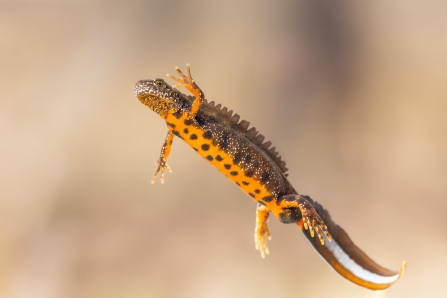
Great Crested Newt Triturus cristatus.
This species is the largest of our native species and grows up to twice the size of the former species. Adult males reach 14-15 cm while females grow to 16 cm. This species has a warty skin which is rough and dark in colour. During the breeding season, the male develops a high spiky crest running down the body and a conspicuous silver stripe along each side of the tail. This stripe is present outside the breeding season but it is not obvious. Both sexes have orange-yellow bellies blotched with black.
Breeding
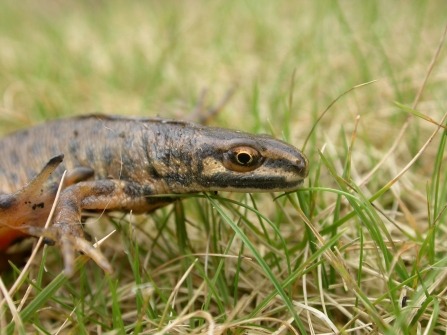
Credit: Philip Precey
Newts migrate to ponds to breed just as frogs and toads do. However, since adults rarely move far from their breeding pond these migrations are not as spectacular as other amphibians. Migration begins in February or March as the spring temperature rises. There is also evidence of an Autumn migration especially of sub-adults so that eggs can be laid before winter. The males reach the pond before the females and spend time feeding well to develop their breeding crests and toe webs. Unlike frogs and toads newts exhibit complex courtship displays which are performed under water. The male carries out a sequence of fanning and waving of the tail and then deposits a spermatophore (package of sperm) close to the female. He then displays further to encourage her to pick the sperm up so that her eggs can be fertilised internally. Newt eggs are laid singly and are usually folded into the leaf of a water plant. The 200-300 eggs laid by the female hatch after 2-3 weeks.
Habitats
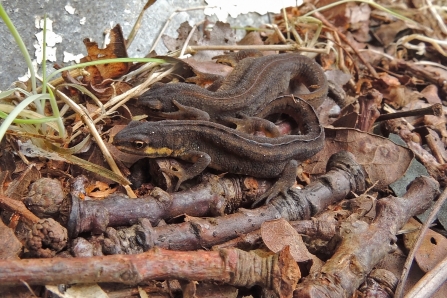
Credit: Margaret Holland
The smooth newt is the commonest species and is widespread over most of the country. This is the newt you are most likely to see in your garden pond. Great crested newt distribution tends to be more patchy, being quite uncommon. The palmate newt also has a widespread distribution but is rarely found in the West Midlands. Smooth and great crested newts are the most likely to be seen together, although all three species can co-exist in ponds.
When on land, newts occupy a diverse range of damp habitats ranging from woodlands and pastures to gardens. During the summer in hot dry spells, newts may hibernate on land, hiding in damp locations until the weather cools. Though tolerant of low temperatures, they must hibernate over winter. In October/November, the newts become less visible as they find somewhere to hibernate that will be frost free, and relatively warm and sheltered. They sometimes hibernate in the mud at the bottom of their breeding ponds.
Great Crested Newts in Birmingham and the Black Country
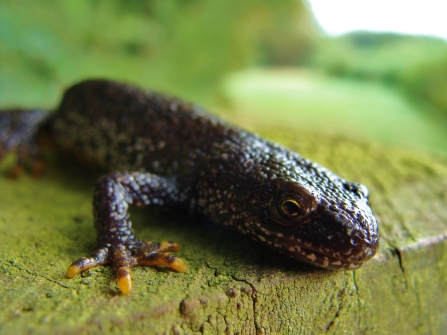
Credit: Kevin Caster
The great crested newt is a species of key priority within the Midlands Plateau Natural Area which encompasses the Birmingham and the Black Country because the area supports a population of great crested newts whose conservation is significant in national terms. Information on the occurrence of the species is patchy. Within Birmingham and the Black Country the species is known to be present in about 30 localities with apparent strongholds in the north west of Dudley and Walsall. The Fens Pools in Pensnett, Dudley is a nationally notable site being notified as a Site of Special Scientific Interest in recognition of the large colony that exists there and the long history of monitoring.
Great crested newts require surprisingly extensive areas of terrestrial habitat as well as standing water in order to survive; for example it has been estimated that a viable population of around two hundred and fifty newts requires a suitable breeding pond and about one hectare of good terrestrial habitat. Moreover, adult newts can travel some distance away from their breeding pond in search of suitable habitat and immature adults may disperse up to five hundred metres away.
The great crested newt, which can grow to sixteen centimetres long is the largest and has special legal protection. It spends much of the year on land, however, towards the end of winter adult newts return to breed. Newt eggs are laid on underwater leaves near the margin. After four weeks the eggs hatch as tadpoles which then take a further three months to develop into a young newt capable of leaving the water. At this time the young newts will leave the water to spend between one and three years in surrounding terrestrial habitat while they become sexually mature.
The species has declined nationally in recent decades at an estimated rate of decline of 2% of colonies per year, i.e. 360 populations. The newt population of Birmingham and the Black Country is presumed to have experienced a decline but no data exists.

